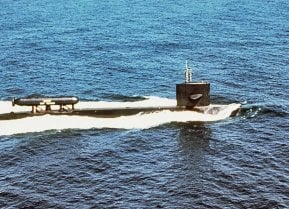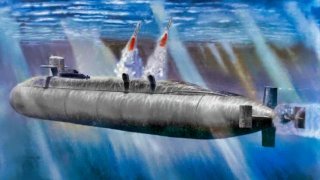Would America Survive a Nuclear First Strike?
No matter how many nuclear weapons you think the United States should have, there needs to be somebody left alive to fire them, or the number may as well be zero
What You Need to Know: Congressman Don Bacon, a retired U.S. Air Force Brigadier General, warns that the United States faces a grave vulnerability to a nuclear first strike by Russia or China due to outdated command and control systems.

-Bacon highlights that the U.S. discontinued its 24/7 airborne alert for its nuclear command post after the Cold War, replacing it with a 15-minute ground alert. However, with modern threats such as hypersonic missiles and anti-satellite weapons, the current system is inadequate for ensuring retaliation.
-Bacon, supported by experts, advocates for the return of airborne or mobile command centers to secure the nation’s nuclear deterrence.
Congressman Warns of U.S. Vulnerability to Russian, Chinese Nuclear Strike
Congressman Don Bacon, a retired U.S. Air Force Brigadier General, believes that the United States has become highly vulnerable to a nuclear first strike by Russia or China. He ought to know. A member of the House Armed Services Committee, the Congressman previously served as the commanding general in LOOKING GLASS - America’s airborne command post - who would, in a nuclear war, take over the U.S. Strategic Command if STRATCOM’s underground command post was knocked out. From 1961 to 1990, the LOOKING GLASS aircraft, airborne twenty-four-seven and relatively invulnerable to attack, provided the best possible guarantee that American nuclear forces would be able to retaliate after a first strike. With the end of the Cold War, it was decided that the airborne alert was no longer necessary. Instead, a smaller fleet of aircraft was maintained on a 15-minute ground alert, to be launched on warning of an attack. That is still the case today.
According to Congressman Bacon, it is now increasingly possible for Russia or China to destroy the aircraft on the ground at the same time as the underground command posts, and thereby effectively decapitate the United States. There are many reasons, he says, why the 15-minute ground alert - which might have been barely adequate in 1990 - can no longer ensure America’s ability to retaliate today. This is, he claims, the gravest deficiency in the national defense; and once the facts of the matter are considered, it is very difficult to disagree with him.
When the airborne alert was shelved in 1990, the situation was as follows. Soviet ballistic missile submarines patrolling off the U.S. coast could hit the aircraft on the ground in as little as eight minutes, in which case the aircraft would not have time to escape. However, the submarine-launched missiles (SLBMs) of the time were relatively poorly suited for attacking hardened targets, such as the Strategic Air Command (now STRATCOM) underground headquarters in Omaha, or the North American Air Defense Command (NORAD) at Cheyenne Mountain, Colorado. Destroying these harder targets with a high degree of confidence required the launch of land-based intercontinental ballistic missiles (ICBMs) from Russian territory, which would take thirty minutes to arrive and would be detected by U.S. satellites soon after launch. The system made some degree of sense because the ground alert aircraft and the underground command posts complimented one another. If the Russians launched ICBMs to take out the underground command posts, the aircraft would have enough warning to escape; whereas if the Russians launched SLBMs to take out the aircraft, there would be at least fifteen minutes between the impact of the first warheads and the destruction of the underground command posts, during which the order to retaliate could be given. In neither case would the U.S. be required to rely completely on its early warning systems, which might risk missing the attack if they were disrupted or start an accidental war if they gave a false alarm.
Naturally, though, technological progress did not stop in 1990. Today, a modern hypersonic boost-glide missile fired from Russian territory could hit the United States in fifteen minutes - inside the margin for the ground alert aircraft. Moreover, even this inadequate window of warning could be closed by modern anti-satellite capabilities, which could take out America’s launch detection satellites before the launch of enemy missiles.

But perhaps worst of all is the danger of space-based nuclear weapons, such as those advertised by Russia earlier this year. Whereas the Administration has downplayed the threat by focusing attention on the potential for orbital nuclear weapons to destroy U.S. satellites, such weapons can also directly attack the United States - by producing EMP bursts to disable U.S. command and control systems, and by suddenly de-orbiting to rain down and destroy them. In either case, says Congressman Bacon, the United States would receive no usable warning at all. Dr Mark Schneider, former Principal Director for Forces Policy at the Pentagon and an expert in the field, agrees with the Congressman’s assessment, and stated that such attacks are probably within Russia’s current capabilities. Moreover, unlike the short-warning weapons of the Cold War era, modern boost-glide missiles and Multiple Orbital Bombardment Systems (MOBS) possess the capabilities to simultaneously destroy both the ground alert aircraft and the hardened command posts, which would decapitate the United States and leave no - one in command of U.S. nuclear weapons.
Furthermore, even if the 15-minute warning time now provided for the ground alert was adequate, the ground alert itself cannot be relied upon, says Bacon. Recalling his experience, he reports that when ordered to scramble, the aircraft would fail to start about one time out of three, and the crew would have to transfer to another aircraft, for which there is - he says - ‘no time.’ In the Congressman’s opinion, ‘a seventy five percent answer is not good enough.’ The author of this article would tend to agree.
To make matters worse, the U.S. never invested in relatively survivable underground command posts, as Russia has. Instead, during the Cold War, the U.S. always relied on redundancy. In addition to the airborne alert which lasted from 1961 - 1990, a separate ground mobile command center - the MCCC - was maintained from the 1980s until 2006. Since both programs were retired, only the vulnerable ground alert aircraft and equally vulnerable hardened command posts now remain.
One popular argument in favor of the status quo is that the U.S. can expect to receive strategic warning (that is, intelligence indicators short of detecting an actual attack in progress) before any attack takes place. Processing these indicators was precisely Congressman Bacon’s role when he was a Lieutenant in the 1980s, and so he is eminently well qualified to judge their value. We ought to take note, then, when the man who actually had to do the job tells us that strategic warning is extremely unreliable and should never be counted on. In fact, successful surprise attacks are historically much more common than cases where states have received strategic warning and acted on it. The United States was famously surprised at Pearl Harbor, and then eight years later in Korea. In 1991, the U.S. received plenty of strategic warning of Iraq’s invasion of Kuwait but chose to ignore it. The wonders of modern technology failed to provide Israel with strategic warning on October 7 of last year. The most obvious case where a state acted upon strategic warning was the Six Day War of 1967, when Israel learned that the Arab states were about to invade and launched a preemptive attack; but just six years later, the Israelis were completely surprised in the war of 1973. In other words, staking the survival of a nation on strategic warning is a non-starter.
In the specific case of the ground alert, there is an even more fundamental problem, says Bacon: the current U.S. fleet is simply too small to maintain a generated airborne alert indefinitely, whether it receives strategic warning or not. Consequently, any U.S. decision to order a temporary airborne alert upon receipt of strategic warning could be countered by simply delaying the strike until the aircraft can no longer keep flying. As a case in point, we are currently in a prolonged nuclear crisis - the Ukraine War - which has been going on for well over two years and shows no sign of abating. During that time, Russian nuclear threats against NATO have become so commonplace that they no longer even constitute front page news. Judging by the history books, we have already received about as much strategic warning as we should ever hope to get.
All these arguments might be overridden if the costs of ensuring a survivable command and control system were prohibitive. However, the opposite is true: the cost of restarting the airborne alert would be a drop in the very large bucket of American defense spending. For instance, in 1989 (while the airborne alert was still underway,) the U.S. command and control fleet consisted of some 44 aircraft. In an unrealistic worst case scenario, assuming all 20 existing aircraft were immediately scrapped and the fleet rebuilt from zero to 44 - using brand new airframes instead of converted ones - it might cost about $13 billion, or approximately 1.5% of annual defense expenditures. Procuring a ground mobile command center such as the old MCCC may be cheaper still. In 1985, when the airborne alert was in full swing, the total cost of all U.S. strategic command and control programs - including the airborne alert and everything else - amounted to about 1% of the total defense budget.


